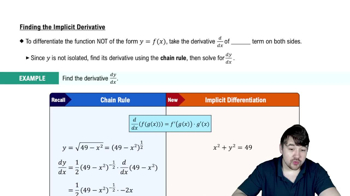Table of contents
- 0. Functions7h 52m
- Introduction to Functions16m
- Piecewise Functions10m
- Properties of Functions9m
- Common Functions1h 8m
- Transformations5m
- Combining Functions27m
- Exponent rules32m
- Exponential Functions28m
- Logarithmic Functions24m
- Properties of Logarithms34m
- Exponential & Logarithmic Equations35m
- Introduction to Trigonometric Functions38m
- Graphs of Trigonometric Functions44m
- Trigonometric Identities47m
- Inverse Trigonometric Functions48m
- 1. Limits and Continuity2h 2m
- 2. Intro to Derivatives1h 33m
- 3. Techniques of Differentiation3h 18m
- 4. Applications of Derivatives2h 38m
- 5. Graphical Applications of Derivatives6h 2m
- 6. Derivatives of Inverse, Exponential, & Logarithmic Functions2h 37m
- 7. Antiderivatives & Indefinite Integrals1h 26m
- 8. Definite Integrals3h 25m
4. Applications of Derivatives
Implicit Differentiation
Problem 3.8.44b
Textbook Question
Volume of a torus The volume of a torus (doughnut or bagel) with an inner radius of a and an outer radius of b is V=π²(b+a)(b−a)²/4.
b. Evaluate this derivative when a=6 and b=10.
 Verified step by step guidance
Verified step by step guidance1
Identify the formula for the volume of the torus: V = \frac{\pi^2 (b + a)(b - a)^2}{4b}.
Substitute the given values a = 6 and b = 10 into the volume formula to express V in terms of these constants.
Differentiate the volume function V with respect to a and b to find the derivative dV/da and dV/db.
Evaluate the derivatives at the specific values a = 6 and b = 10 to find the rate of change of volume with respect to the inner and outer radii.
Interpret the results of the derivatives to understand how changes in the radii affect the volume of the torus.
Was this helpful?

 5:14m
5:14mWatch next
Master Finding The Implicit Derivative with a bite sized video explanation from Nick
Start learningRelated Videos
Related Practice



